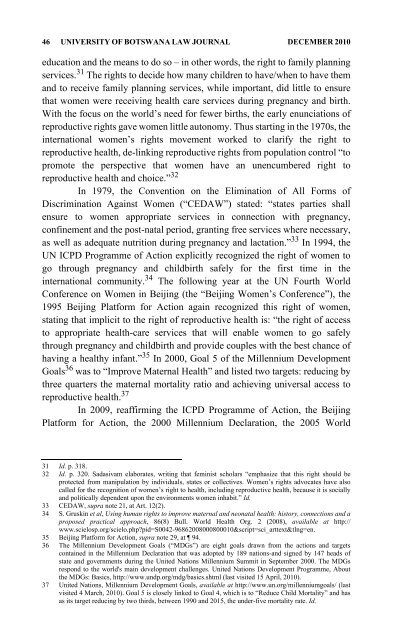University of Botswana Law Journal - PULP
University of Botswana Law Journal - PULP
University of Botswana Law Journal - PULP
Create successful ePaper yourself
Turn your PDF publications into a flip-book with our unique Google optimized e-Paper software.
46 UNIVERSITY OF BOTSWANA LAW JOURNAL DECEMBER 2010<br />
education and the means to do so – in other words, the right to family planning<br />
services. 31 The rights to decide how many children to have/when to have them<br />
and to receive family planning services, while important, did little to ensure<br />
that women were receiving health care services during pregnancy and birth.<br />
With the focus on the world’s need for fewer births, the early enunciations <strong>of</strong><br />
reproductive rights gave women little autonomy. Thus starting in the 1970s, the<br />
international women’s rights movement worked to clarify the right to<br />
reproductive health, de-linking reproductive rights from population control “to<br />
promote the perspective that women have an unencumbered right to<br />
reproductive health and choice.” 32<br />
In 1979, the Convention on the Elimination <strong>of</strong> All Forms <strong>of</strong><br />
Discrimination Against Women (“CEDAW”) stated: “states parties shall<br />
ensure to women appropriate services in connection with pregnancy,<br />
confinement and the post-natal period, granting free services where necessary,<br />
as well as adequate nutrition during pregnancy and lactation.” 33 In 1994, the<br />
UN ICPD Programme <strong>of</strong> Action explicitly recognized the right <strong>of</strong> women to<br />
go through pregnancy and childbirth safely for the first time in the<br />
international community. 34 The following year at the UN Fourth World<br />
Conference on Women in Beijing (the “Beijing Women’s Conference”), the<br />
1995 Beijing Platform for Action again recognized this right <strong>of</strong> women,<br />
stating that implicit to the right <strong>of</strong> reproductive health is: “the right <strong>of</strong> access<br />
to appropriate health-care services that will enable women to go safely<br />
through pregnancy and childbirth and provide couples with the best chance <strong>of</strong><br />
having a healthy infant.” 35 In 2000, Goal 5 <strong>of</strong> the Millennium Development<br />
Goals 36 was to “Improve Maternal Health” and listed two targets: reducing by<br />
three quarters the maternal mortality ratio and achieving universal access to<br />
reproductive health. 37<br />
In 2009, reaffirming the ICPD Programme <strong>of</strong> Action, the Beijing<br />
Platform for Action, the 2000 Millennium Declaration, the 2005 World<br />
31 Id. p. 318.<br />
32 Id. p. 320. Sadasivam elaborates, writing that feminist scholars “emphasize that this right should be<br />
protected from manipulation by individuals, states or collectives. Women’s rights advocates have also<br />
called for the recognition <strong>of</strong> women’s right to health, including reproductive health, because it is socially<br />
and politically dependent upon the environments women inhabit.” Id.<br />
33 CEDAW, supra note 21, at Art. 12(2).<br />
34 S. Gruskin et al, Using human rights to improve maternal and neonatal health: history, connections and a<br />
proposed practical approach, 86(8) Bull. World Health Org. 2 (2008), available at http://<br />
www.scielosp.org/scielo.php?pid=S0042-96862008000800010&script=sci_arttext&tlng=en.<br />
35 Beijing Platform for Action, supra note 29, at 94.<br />
36 The Millennium Development Goals (“MDGs”) are eight goals drawn from the actions and targets<br />
contained in the Millennium Declaration that was adopted by 189 nations-and signed by 147 heads <strong>of</strong><br />
state and governments during the United Nations Millennium Summit in September 2000. The MDGs<br />
respond to the world's main development challenges. United Nations Development Programme, About<br />
the MDGs: Basics, http://www.undp.org/mdg/basics.shtml (last visited 15 April, 2010).<br />
37 United Nations, Millennium Development Goals, available at http://www.un.org/millenniumgoals/ (last<br />
visited 4 March, 2010). Goal 5 is closely linked to Goal 4, which is to “Reduce Child Mortality” and has<br />
as its target reducing by two thirds, between 1990 and 2015, the under-five mortality rate. Id.
















